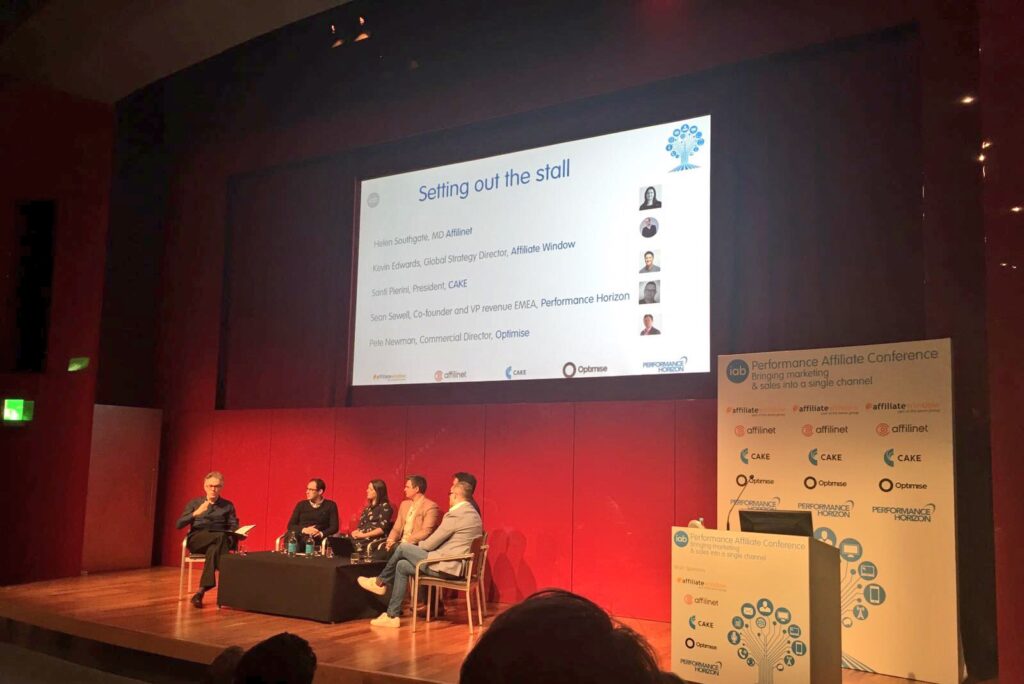

Our own VP Revenue, EMEA Sean Sewell sharing his insights in the sponsors panel session
As brands embrace “digital transformation” in 2017, the evolution of the performance marketing landscape continues to accelerate. This was a key focus at the inaugural Internet Advertising Bureau’s (IAB) Performance Affiliate Marketing Conference last week in London.
Over one hundred marketers representing leading brands and agencies including BT, Tesco, PwC, Maple Syrup Media gathered together to discuss how digital transformation is forcing businesses to rethink their marketing processes and the growing reliance on performance marketing to achieve overall business objectives.
Over the past several years, we’ve seen a tremendous increase in the number of brands who are successfully driving growth through innovative marketing partnerships. From the conference, we identified a few key trends for performance marketers to keep an eye out for in 2017.
1. Customer LTV is King
Demonstrating incremental value in partner marketing has become increasingly critical to help illustrate the significance of the channel. As programmes mature, brands are turning their attention to driving the right type of customer by measuring life time value as opposed to focusing purely on volume.
This is a continuing trend from 2016 reinforced by findings in travel and retail performance marketing benchmarking reports last year which found that a surprising 22% of retailers and 24% of travel brands now use performance marketing for customer retention, which is a nontraditional use of the channel.
Brands who develop creative reward structures to incentivize partners on a range of variables to drive more valuable customers will be best-suited to capitalise on this trend.
2. Finding the right partners is key to reaching the right audiences
In 2017, it will be increasingly important for brands to focus on building strong, direct relationships with the right partners – especially when expanding into new markets. Not all customers are created equal, so ensuring that you’re working with the right partners who demonstrate their ability to drive sales on profitable products is critical to helping you align your partner marketing activities to your broader business goals.
Building strong relationships is an ongoing process that requires substantial time and energy. Partner marketing technology can significantly aid brands in this area by allowing brands to shift their resources away from basic program administration and instead allowing them to focus on strategizing with their key partners.
3. Marketplace and meta search partners expand into new niches
We are also beginning to see new niches in which marketplace partners are emerging. This follows the rising popularity of meta search engines and aggregators in verticals such as travel, retail, real estate, etc. These new niches enable them to connect customers with brands based on a consumer’s specific wants and needs. For example, publishers such as Hoop, who connect families with child-friendly activities in their local area, are bringing this type of offering to major brands who have budgets big enough to slot this activity straight into their existing affiliate programmes.
As more and more brands develop innovative new partner models, it will be critical to incorporate them into existing affiliate programmes to standardize how all of these partnerships are measured, tracked, and rewarded.
4. Players in VR, AR, & IOT are becoming viable marketing partners
Emerging technologies like virtual and augmented reality open up the field for entirely new partner categories. Companies developing VR & AR content are capable of engaging with customers in a more immersive way than ever before. For example, Snapchat’s photo filters are a great example of a successful application of augmented reality to connect with consumers.
It will be very interesting to watch how brands maximise these connections and find ways to creatively promote themselves. For instance, these could take on forms similar to those of TV product placements, sponsorships, or Out of Home advertisements—but, in a virtual environment.
A version of this post was originally published with the IAB on February 8th, 2017